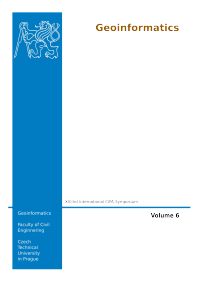Learning from the Building: Direct Sources for the Preservation Project. The Experience of Besozzo's Town Hall (Varese, Italy)
DOI:
https://doi.org/10.14311/gi.6.7Keywords:
knowledge, architecture, surveying, stratigraphy analysis, documentation, conservationAbstract
The Town Hall of Besozzo (Varese, Italy) is located in the city centre of the village and its first construction phase is dated back to the XIV-XV century. It shows a complex palimpsest which is the result of the numerous transformations occurred during its life: enlargements, super elevations, demolitions, inner spaces subdivisions and use changes. Currently a project has been issued for the reuse of the building which assigns new spaces for the town offices to the northern wing recently acquired. The aim of the research was to provide a diagnostic insight, useful for the development of the conservation project which will necessarily take into account the multitude of values registered on the building. Owing to a lack of meaningful archival documentation, the elevation’s stratigraphic reading and the methods for dating historical buildings proved to be an invaluable resource for the comprehension of the building’s transformations. Cross-referencing readings of indirect sources carried on the building with the results of the in-depth analysis made it possible to rebuild the growth of the structure from its origin to the present days. Such analysis includes: geometric survey, photographic rectifications of facade and inner sections, non-destructive diagnostic investigations, bricks, mortar and plaster chemical-physical analysis, mensiochronology, study of the building techniques and chronotypology which is a stylistic analysis performed both on the constructive (apertures) and decorative (shelves, graffiti, colourings traces) architectural elements. Blending the results of these dating techniques produced the complexity of the stratigraphic reading which has been conveyed with adequate hatching on the rectified images (U.S. – Stratigraphic Unity) while schematic 3D reconstructions exemplify the chronological sequence of the building activities. Individuation and comprehension of the building constructive phases made also possible to understand which were the different uses of each room inside this domestic architecture thus providing the client and the bodies in charge of protection with valuable data for the preservation project.References
Brunella, R.L.: Frammenti di storia besozzese. Brevi notizie preistoriche e storiche di Besozzo e dintorni, Besozzo, 1960.
Boriani, M.(a cura di): Patrimonio archeologico, progetto architettonico e urbano, Firenze, 1997.
Bortolotto, S.: Il rilievo stratigrafico, in C. Campanella (a cura di) “Il rilievo degli edifici”, Milano, 2004, pp.94115.
Bortolotto, S., Colla, C., Mirandola, D., Sponchioni, A.: Palazzo Cittadini Stampa: role of stratigraphy and cinematic analysys in the knowledge of a mansonry building,, C. Modena, P.B. Lourenco, P. Roca (a cura di), Structural analysis of historical constructions. Possibilities of numerical and experimental techniques, London, 2005, 1, 167-175.
Bortolotto, S., Campanella, C., Tessoni, M., Macchi, A.: Methods for dating historical buildings and verticality control of the Baronale Palace at Avio’s Castle (TN), CIPA: “International cooperation to save the world's cultural heritage”, Torino, settembre 2005, 177-182.
Parenti, R.: Sulle possibilità di datazione e di classificazione delle murature, in R. Francovich, R. Parenti (a cura di), Archeologia e restauro dei monumenti, Firenze, 1988, 280-304.
Gabrielli, F.: La “cronotipologia relativa” come metodo di analisi degli elevati: la facciata del Palazzo Pubblico di Siena, Archeologia dell'Architettura”, I, 1996, 17-40.
Mannoni, T., Milanese, M.: Mensiocronologia, in R. Francovich, R. Parenti (a cura di), Archeologia e restauro dei monumenti, Firenze, 1988, 383-402.
Downloads
Published
Issue
Section
License
- Authors retain copyright and grant the journal right of first publication with the work simultaneously licensed under a Creative Commons Attribution License that allows others to share the work with an acknowledgement of the work's authorship and initial publication in this journal.
- Authors are able to enter into separate, additional contractual arrangements for the non-exclusive distribution of the journal's published version of the work (e.g., post it to an institutional repository or publish it in a book), with an acknowledgement of its initial publication in this journal.
- Authors are permitted and encouraged to post their work online (e.g., in institutional repositories or on their website) prior to and during the submission process, as it can lead to productive exchanges, as well as earlier and greater citation of published work (See The Effect of Open Access).

